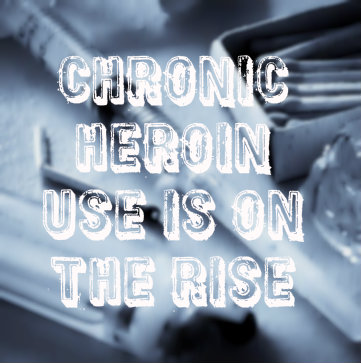Chronic Heroin Use Is On The Rise
Heroin is perhaps the most widely known opioid narcotic drug of abuse. In addition to opioid addiction, chronic users of this drug typically face a range of serious and potentially fatal health problems. In a report presented in March 2014 to the White House Office of National Drug Control Policy, a team of researchers from the RAND Corporation estimated how many people in the U.S. qualified as chronic heroin users in the years between 2000 and 2010. This report includes detailed information on the levels of drug intake found among chronic users.
 What Is Considered Chronic Use?
What Is Considered Chronic Use?
The federal Substance Abuse and Mental Health Services uses data from a yearly undertaking called the National Survey on Drug Use and Health to estimate how many Americans age 12 or older use heroin to any extent in the average month. The latest findings from this survey were released in the fall of 2013 and contain information compiled for most of 2012 and a short segment of 2011. According to these findings, roughly 335,000 adults and teenagers took heroin at least once in a representative 30-day timeframe. Altogether, about double that amount (669,000) took the drug at least once during the yearlong survey period. The figures for monthly heroin use were higher in 2012 than at any point since 2006. The figures for yearly use were higher in that year than for any year in the previous decade.
The Levels Of Chronic Heroin Use
Chronic drug use is a descriptive and useful but fairly imprecise term. Some chronic users may take a given drug four to 10 times a month, while others may have a more accelerated pattern of intake and take a drug 11 to 20 days per month. Still other chronic users may have heavily accelerated patterns of intake and take a given drug 21 days or more per month. As a rule, repeated use of an addictive substance is highly associated with chances for abusing that substance and developing the symptoms of drug addiction. For this reason, chronic users account for the vast majority of people directly affected by abuse- and addiction-related problems. Heroin is particularly noted for its potential to trigger abuse and addiction in repeated users. Users of the drug who develop these problems qualify for diagnosis of a condition officially known as opioid use disorder.
How Many Chronic Heroin Users Are There?
In the report presented to the White House Office of National Drug Control Policy, the RAND Corporation researchers calculated the number of chronic heroin users in the U.S. with information gathered from several highly regarded sources, including the federally sponsored National Survey on Drug Use and Health and Arrestee Drug Abuse Monitoring Program. This information covers the timeframe between the years 2000 and 2010. In 2010, the probable number of chronic heroin users hovered at about 1.5 million. Less likely numbers included a low estimate of 800,000 chronic users and a high estimate of 2.6 million chronic users. The number of chronic heroin users calculated by the RAND Corporation researchers is much higher than the total number of heroin users identified by the National Survey on Drug Use and Health. This is largely attributable to the researchers’ inclusion of information from the Arrestee Drug Abuse Monitoring Program, which covers a large pool of people (the arrested and the imprisoned) affected by an uncommonly high rate of substance use.
Roughly 300,000 of the individuals identified by the researchers as chronic heroin users took the drug four to 10 days per month. Another 200,000 identified individuals took the drug 11 to 20 days per month. Two-thirds (1 million) of those identified as chronic heroin users took the drug 21 days or more per month.
The authors of the report presented to the White House Office of National Drug Policy note that it’s fairly difficult to accurately estimate the number of people affected by chronic heroin use. This is due, in large part, to the problems involved in tracking the relatively small segment of the total population that takes the drug. On an important note, the data used by the report’s authors did not extend into 2011, 2012 and 2013. Figures from the National Survey on Drug Use point toward a sharp increase in overall heroin use during 2011 and 2012 (as of early 2014, figures for 2013 have not been released).
Find Out About Naloxone – A Potential Lifesaver For Heroin Addicts



